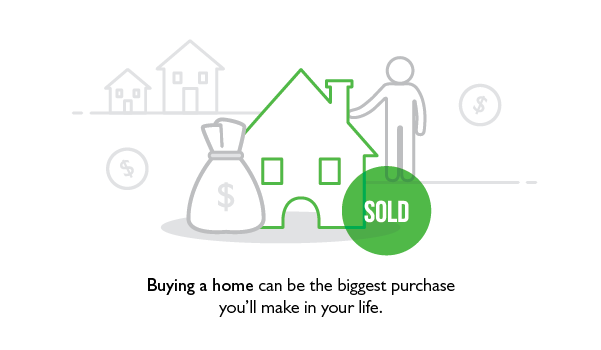The homebuying journey can be complicated and time-consuming. It’s often the largest purchase consumers make in their lifetime so it’s important to learn as much as possible about how to buy a home.
The average buyer who uses the internet to help their house hunt spends 10 weeks evaluating various available homes, according to the National Association of Realtors.
After that, the mortgage closing process takes 47 days, on average, from the time a prospective homebuyer applies for a loan to the time they receive the funding, according to ValuePenguin.
Beginning this process for the very first time can be a bit intimidating, but it doesn’t have to be. Here’s what you can expect from the homebuying process, in five steps:
Step 1: Get pre-qualified for a loan
Your first home will likely be one of the biggest purchases you’ll make in your life. Approaching this process with a clear idea of how much house you can afford will help you make smart money decisions.
Pre-qualification is a process you’ll work through with your lender to evaluate your current financial situation, assess how much cash you can put toward your down payment and other upfront expenses, and how much your monthly payments will be.
Getting pre-qualified isn’t difficult. There are several ways you can go about it:
- Online: Many lenders today, including Bank Midwest, have options to start the pre-qualification process online. Check out our Mortgage Center to begin the application process online with Bank Midwest.
- Phone: For those who are more comfortable discussing the process over the phone, Bank Midwest customers can call 888.902.5662 to speak with a Mortgage Lender who can explain all the components of pre-qualification.
- In person: Finally, customers can visit their local Bank Midwest branch to speak face-to-face with a Mortgage Lender about pre-qualification and the overall loan approval process.
To become pre-qualified, you’ll need to provide the lender with some information about your current financial situation, including proof of income, proof of assets and more. This will help them evaluate how much you can afford to spend on your home.
Some required documents you’ll likely need include W-2 statements for the past two years, bank and investment account statements, and your credit report (which the lender can pull for you if you give them permission to do so).
The result of this process is a pre-qualification letter, which will outline how much money the lender is likely to approve you for. It may be exciting to see the dollar amount on paper, but before you go out house hunting, keep a few important things in mind:
- Pre-qualification is not a guarantee. When you apply for a loan, you may actually be approved for less than the amount listed on your prequalification letter.
- You don’t have to spend all the money you’re approved for. Buying a home for less than you’re approved for may help you save money and remain financially healthy.
- Changes in your financial situation can impact your ability to get a loan. If you have a change in employment or income, or if you spend or receive a large sum of money, tell your lender right away.

Step 2: Shop for your new house
Once you have a clear idea of how much home you can afford, you can begin seriously house hunting.
But before you begin, consider the things you want and need in a home. As yourself questions like:
- How many bedrooms do you need now, and how many will you need in five years?
- How long of a commute to work, school or amenities are you willing to take?
- What home features can you not live without?
- Are you willing to pay homeowners association fees?
For most homebuyers, a real estate agent plays a big role in helping them find the perfect home. In fact, 16% of homebuyers in 2019 contacted a real estate agent before they began looking at homes online, according to the NAR. These professionals have access to databases filled with information about which homes are for sale, and even homes that haven’t yet gone on the market but will soon be listed.
Prospective buyers may not be able to attend open houses in the same way that buyers in the past have, due to restrictions pertaining to the coronavirus pandemic. Virtual open houses may be a good alternative option to learn about various homes on the market.
Step 3: Make an offer
Once you’ve found a great home you can see yourself living in for the foreseeable future, it’s time to make an offer.
This is your opportunity to state how much you’re willing to spend on the home, and to list out contingencies, or events that will negate the offer. According to the Zillow Group Consumer Housing Trends Report 2019 survey, 74% of people put contingencies in their offers.
Some common contingencies homebuyers list in their offers include:
- Inspection contingency: Offer depends on positive results from a professional home inspection.
- Appraisal contingency: Offer depends on the appraisal indicating that the offer is in line with the fair market value of the home.
- Financing contingency: Offer depends on the buyer securing a mortgage.
Once you’ve made your offer, it’s time to arrange an inspection and appraisal. Feel free to accompany the professionals conducting these assessments, and to ask questions along the way. The more you know about the home ahead of time, the better.
Step 4: Finalize your loan
Finally, you will once again speak with your lender. If you were pre-qualified ahead of time and your financial situation hasn’t changed, the process of finalizing your loan shouldn’t take long.
However, you may still need to provide additional documentation that explains your financial situation, such as tax returns for the past two years, a Gift Funds Letter (if you’re using gifted money in the purchase) and the purchase agreement for the home, including all counter offers, addendums and earnest money checks.
Your lender will likely review different types of home loans with you. The most common mortgage type is the 30-year fixed-rate mortgage. This type of loan will give you the same interest rate for the entire 30 years of the loan, which makes budgeting simple.
Other types of mortgage loans may have:
- Different terms, such as 10 or 15 years.
- Adjustable rates, which means the interest rate may fluctuate annually based on market conditions.
- Specific requirements, such as USDA loans in rural areas of the country, or VA loans for veterans or active-duty service members and their families.
Once you and your lender determine the best mortgage for your situation, you can finalize the loan. Soon, you’ll receive the keys to your new home.
Step 5: Get homeowners insurance
It’s wise to get a homeowners insurance policy as soon as possible; you may even begin researching these prior to finalizing your purchase.
In some cases, homeowners include insurance contingencies in their offers to protect them in instances where they can’t obtain coverage for certain events, such as earthquakes in areas where these are common, or toxic mold in homes with a history of this issue, NOLO explained.
Homeowners insurance will protect you financially in the event that your home sustains damage or becomes unlivable because of a disaster. Having this coverage in place from Day 1 of homeownership can provide you peace of mind that your investment is protected against the unexpected.
Bank Midwest makes the process of getting a homeowners insurance policy simple. Our mortgage and insurance professionals work closely together to ensure you have the right coverage for your needs.
Looking for more information about the homebuying process and how Bank Midwest can help you along the way?
Check out The First-Time Homebuyer’s Handbook; it takes you through every step of the process, from pre-qualification to move-in.

